Optimal Scheduling of Island Microgrid with Seawater-Pumped Storage Station and Renewable Energy
Abstract
1. Introduction
- Based on the equivalent model of seawater-pumped storage station’s reservoir, the optimal scheduling method model of seawater-pumped storage station in island microgrid is established for the first time;
- A coordinated optimal dispatching model of seawater-pumped storage station and renewable energy is suggested;
- An optimal scheduling method for island microgrid with seawater-pumped storage station is proposed for the first time.
2. Problem Description and Optimization Framework
2.1. Microgrid Description
2.2. Optimization Framework
- Short-term forecast data of renewable energy and loads;
- Parameters of seawater-pumped storage station;
- Parameters of interruptible loads, diesel generator, wind turbines and photovoltaic system;
- Power outputs of diesel generator and seawater-pumped storage unit;
- State variables of interruptible loads, diesel generator, seawater-pumped storage unit in generating and pumping status;
- Wind and photovoltaic power curtailments;
- Curtailment of rigid loads.
3. Scheduling Model of the Island Microgrid
3.1. Model of Variable-Speed Seawater-Pumped Storage Station
3.1.1. Equivalent Reservoir Model of Variable-Speed Seawater-Pumped Storage Station
3.1.2. Generating and Pumping Models
3.1.3. Operation and Maintenance Costs of Variable-Speed Seawater-Pumped Storage Station
3.2. Model of Renewable Energy
3.2.1. Wind Turbine
3.2.2. Photovoltaic Model
3.3. Diesel Generator Model
3.4. Objective Function
3.5. Constraints
3.5.1. Power Balance Equality Constraint
3.5.2. Variable-Speed Seawater-Pumped Storage Station Constraints
3.5.3. Diesel Generator Constraints
3.5.4. Renewable Energy Constraints
3.5.5. Reserve Capacity Constraint
3.6. Approach to Solving the Proposed Model
4. Case Study
4.1. Framework of Island Microgrid
4.2. Results and Discussion
5. Conclusions
Author Contributions
Funding
Conflicts of Interest
References
- Kwon, S.; Won, W.; Kim, J. A superstructure model of an isolated power supply system using renewable energy: Development and application to Jeju Island, Korea. Renew. Energy 2016, 97, 177–188. [Google Scholar] [CrossRef]
- Zhang, Z.; Wang, Z.; Chen, Z.; Wang, G.; Shen, N.; Guo, C. Study on Grid-Connected Strategy of Distribution Network with High Hydropower Penetration Rate in Isolated Operation. Processes 2019, 7, 328. [Google Scholar] [CrossRef]
- Chen, H.; Xuan, P.; Wang, Y.; Jin, X. Key Technologies for Integration of Multitype Renewable Energy Sources—Research on Multi-Timeframe Robust Scheduling/Dispatch. IEEE Trans. Smart Grid 2017, 7, 471–480. [Google Scholar] [CrossRef]
- Kaldellis, J.K.; Kavadias, K.; Zafirakis, D. The role of hydrogen-based energy storage in the support of large-scale wind energy integration in island grids. Int. J. Sol. Energy 2015, 34, 188–201. [Google Scholar] [CrossRef]
- Park, E.; Yoo, K.; Ohm, J.; Kwon, S. Case study: Renewable electricity generation systems on Geoje Island in South Korea. J. Renew. Sustain. Energy 2016, 8, 151–164. [Google Scholar] [CrossRef]
- Sheng, L.; Zhou, Z.; Charpentier, J.F.; Benbouzid, M.E.H. Stand-alone island daily power management using a tidal turbine farm and an ocean compressed air energy storage system. Renew. Energy 2017, 103, 286–294. [Google Scholar] [CrossRef]
- Notton, G.; Mitrushi, D.; Stoyanov, L.; Berberi, P. Operation of a photovoltaic-wind plant with a hydro pumping-storage for electricity peak-shaving in an island context. Sol. Energy 2017, 157, 20–34. [Google Scholar] [CrossRef]
- Koritarov, V.; Veselka, T.D.; Gasper, J.; Bethke, B.M.; Botterud, A.; Wang, J.; Mahalik, M.; Zhou, Z.; Milostan, C.; Feltes, J. Modeling and Analysis of Value of Advanced Pumped Storage Hydropower in the United States. Science 2014, 246, 25–31. [Google Scholar]
- Papaefthymiou, S.V.; Papathanassiou, S.A. Optimum sizing of wind-pumped-storage hybrid power stations inisland systems. Renew. Energy 2014, 64, 187–196. [Google Scholar] [CrossRef]
- Canales, F.A.; Beluco, A.; Carlos, M. A comparative study of a wind hydro hybrid system with water storage capacity: Conventional reservoir or pumped storage plant? J. Energy Storage 2015, 4, 96–105. [Google Scholar] [CrossRef]
- Zhao, G.; Ren, J. Research on an Output Power Model of a Doubly-Fed Variable-Speed Pumped Storage Unit with Switching Process. Appl. Sci. 2019, 9, 3368. [Google Scholar] [CrossRef]
- Pina, A.; Ioakimidis, C.S.; Ferrao, P. Economic modeling of a seawater pumped-storage system in the context of São Miguel. In Proceedings of the 2008 IEEE International Conference on Sustainable Energy Technologies, Singapore, 24–27 November 2008. [Google Scholar]
- Hiratsuka, A.; Arai, T.; Yoshimura, T. Seawater pumped-storage power plant in Okinawa island, Japan. Eng. Geol. 1993, 35, 237–246. [Google Scholar] [CrossRef]
- Katsaprakakis, D.; Christakis, D.; Stefanakis, I.; Spanos, P.; Stefanakis, N. Technical details regarding the design, the construction and the operation of seawater pumped storage systems. Energy 2013, 55, 619–630. [Google Scholar] [CrossRef]
- Cao, Y.; Wang, K.; Shi, W.; Li, G. Study on dispatching strategies of a wind-solar-seawater pumped storage hybrid power system. Power Syst. Prot. Control 2018, 46, 16–23. [Google Scholar]
- Liang, N.; Deng, C.; Chen, Y.; Yao, W.; Li, D.; Chen, M.; Peng, P. Two-Stage coordinate optimal scheduling of seawater pumped storage in active distribution networks. Sustainability 2018, 10, 2014. [Google Scholar] [CrossRef]
- Fan, L.; Wang, K.; Li, G.; Shi, W.; Liu, X. An optimization dispatch study of micro grid with seawater pumped storage plant in isolated island. Power Syst. Technol. 2016, 40, 382–386. [Google Scholar]
- Liu, Z. Application of Seawater Pumped Storage Technology in Island Power Supply. Power Energy 2017, 38, 593–597. [Google Scholar]
- Qian, G. Brief Introduction of Chinese Seawater Pumped Storage Power Station’s Resources. Hydropower Pumped Storage 2017, 3, 1–6. [Google Scholar]
- Zhang, H.; Wu, S.; Rui, D.; Zhang, D. Study on Selection and Development of Demonstration Project of Seawater Pumped Storage Power Station in China. Hydropower Pumped Storage 2017, 3, 7–10. [Google Scholar]
- Portero, U.; Velázquez, S.; Carta, J.A. Sizing of a wind-hydro system using a reversible hydraulic facility with seawater. A case study in the Canary Islands. Energy Convers. Manag. 2015, 106, 1251–1263. [Google Scholar] [CrossRef]
- Manfrida, G.; Secchi, R. Seawater pumping as an electricity storage solution for photovoltaic energy systems. Energy 2014, 69, 470–484. [Google Scholar] [CrossRef]
- Katsaprakakis, D.A.; Christakis, D.G. Seawater pumped storage systems and offshore wind parks in islands with low onshore wind potential. A fundamental case study. Energy 2014, 66, 470–486. [Google Scholar] [CrossRef]
- Hessami, M.A.; Bowly, D.R. Economic feasibility and optimisation of an energy storage system for Portland Wind Farm (Victoria, Australia). Appl. Energy 2011, 88, 2755–2763. [Google Scholar] [CrossRef]
- Mclean, E.; Kearney, D. An Evaluation of Seawater Pumped Hydro Storage for Regulating the Export of Renewable Energy to the National Grid. Energy Procedia 2014, 46, 152–160. [Google Scholar] [CrossRef]
- Bowden, G.J.; Barker, P.R.; Shestopal, V.O.; Twidell, J.W. Weibull distribution function and wind power statistics. Wind Eng. 1983, 7, 85–98. [Google Scholar]
- Yan, G.; Wang, Z.; Li, J.; Feng, L. Research on output power fluctuation characteristics of the clustering photovoltaic-wind joint power generation system based on continuous output analysis. In Proceedings of the 2014 International Conference on Power System Technology (POWERCON), Chengdu, China, 20–22 October 2014. [Google Scholar]
- Jon, L.; Sven, L. Mixed Integer Nonlinear Programming. International 2001, 9, 373–395. [Google Scholar]
- GAMS. Available online: https://www.gams.com/ (accessed on 5 May 2020).
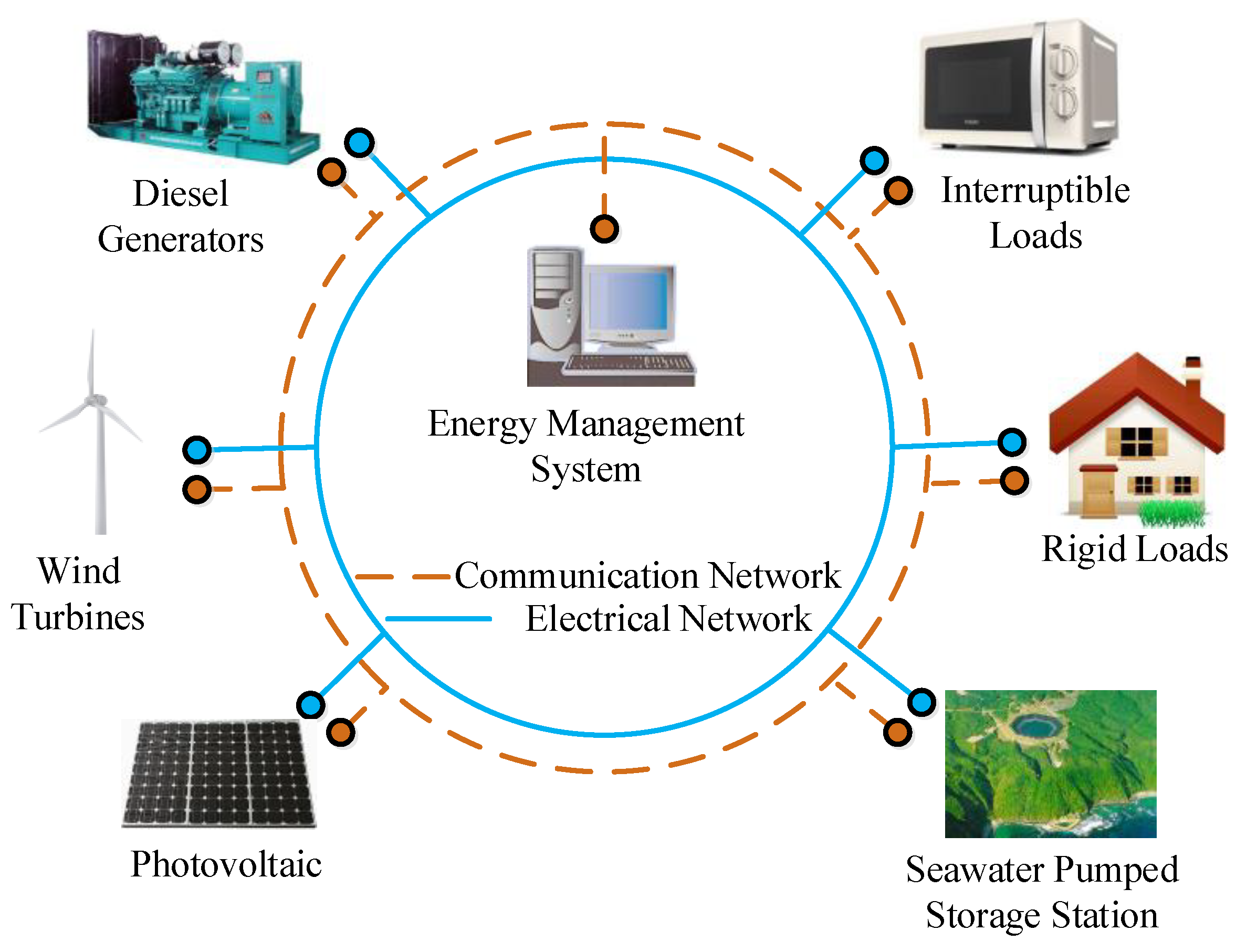
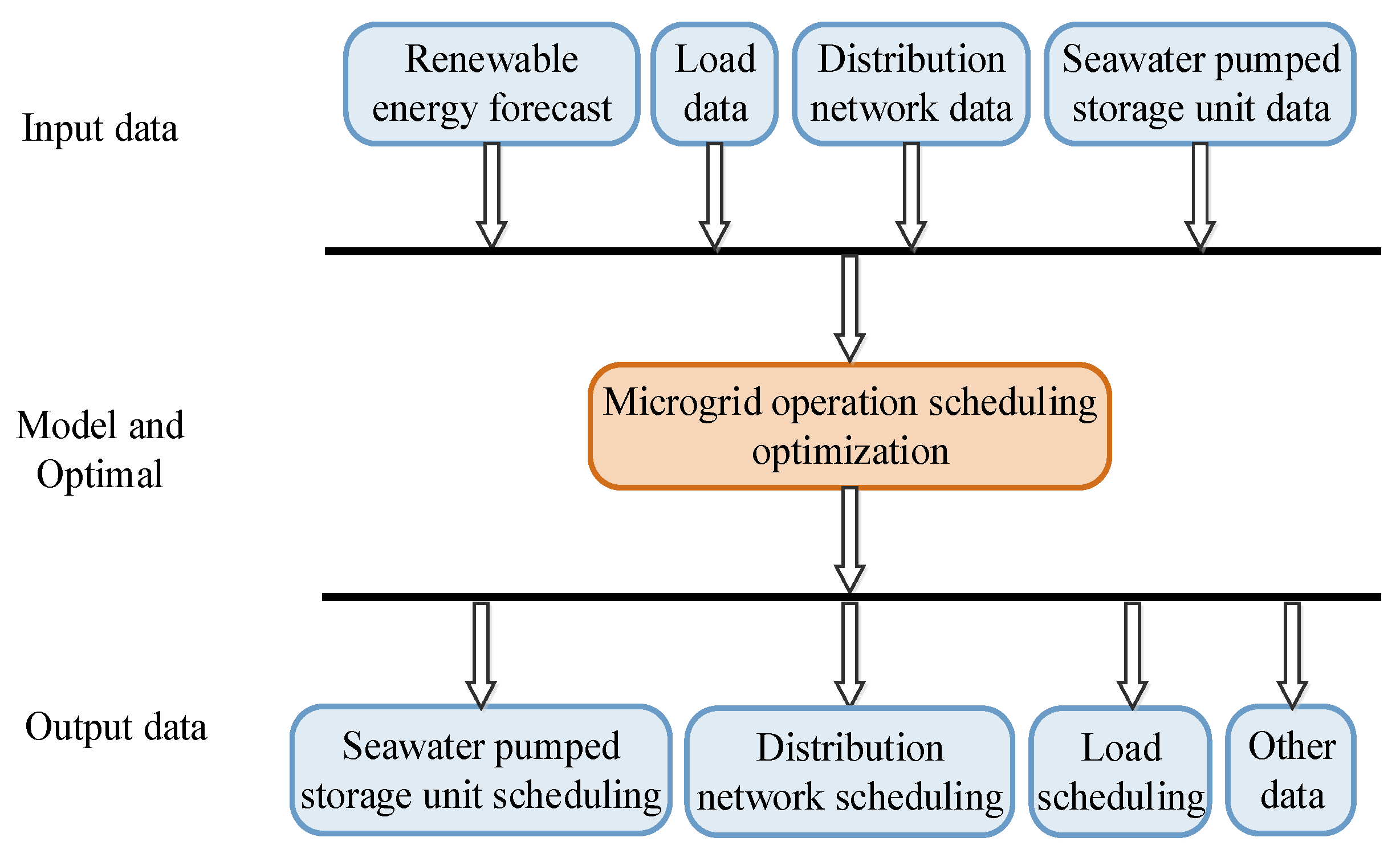
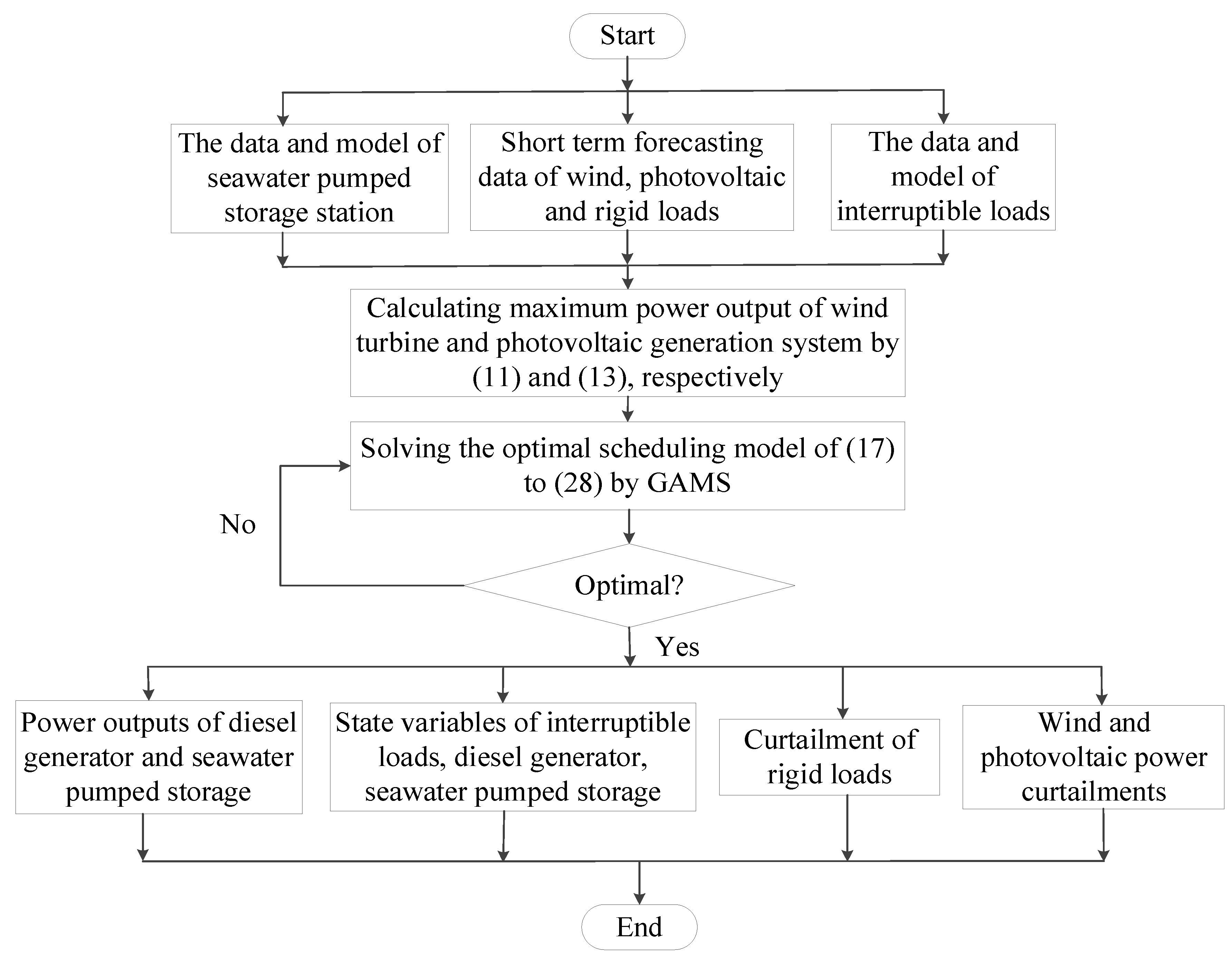
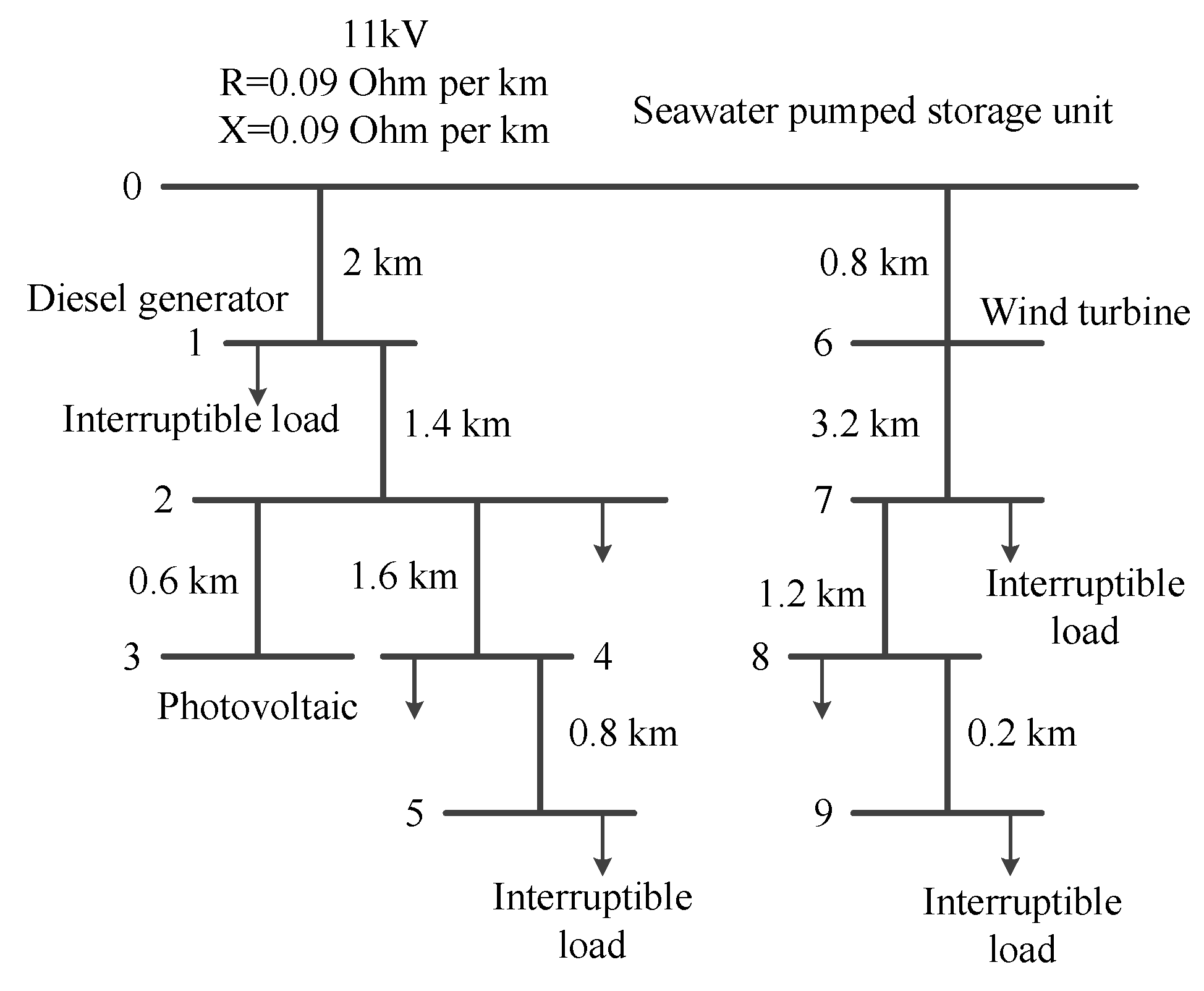


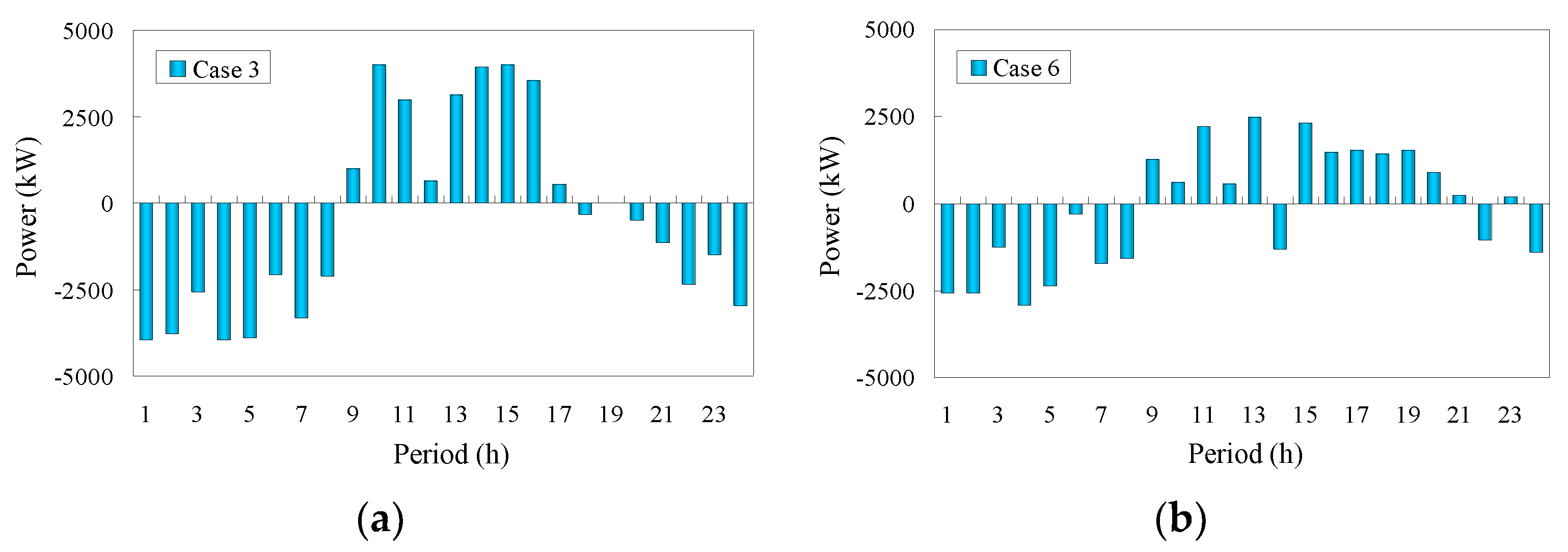
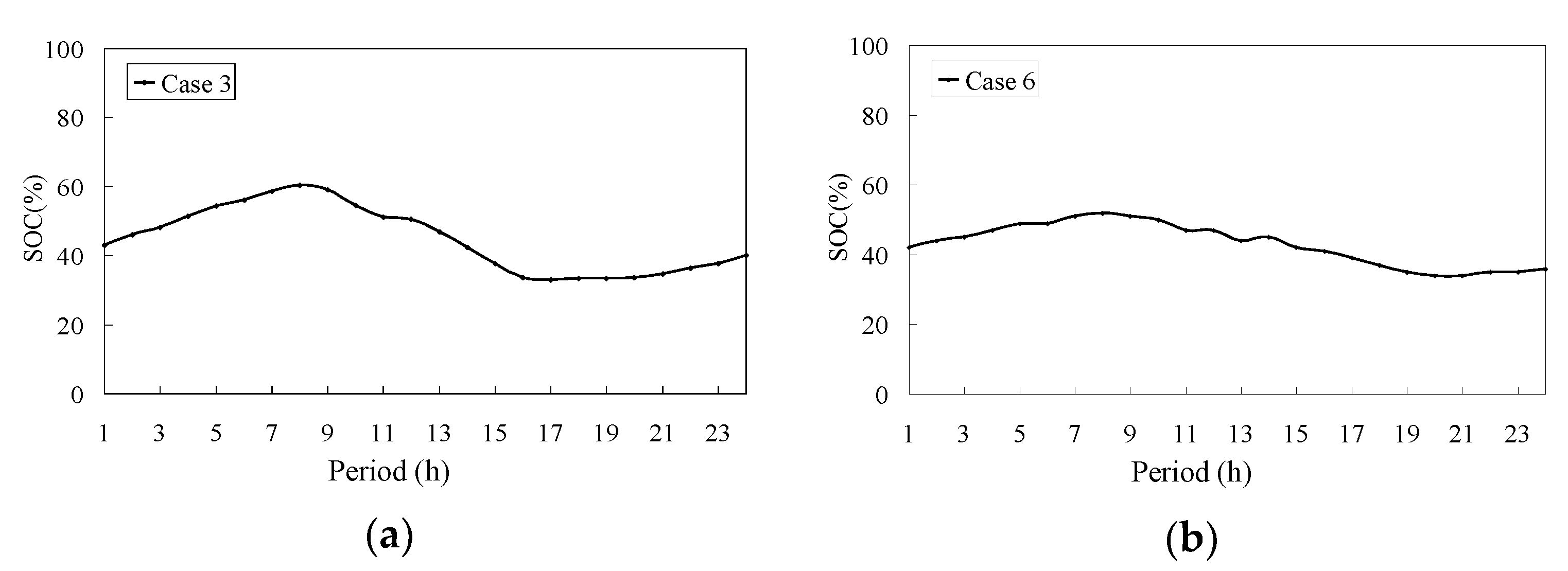
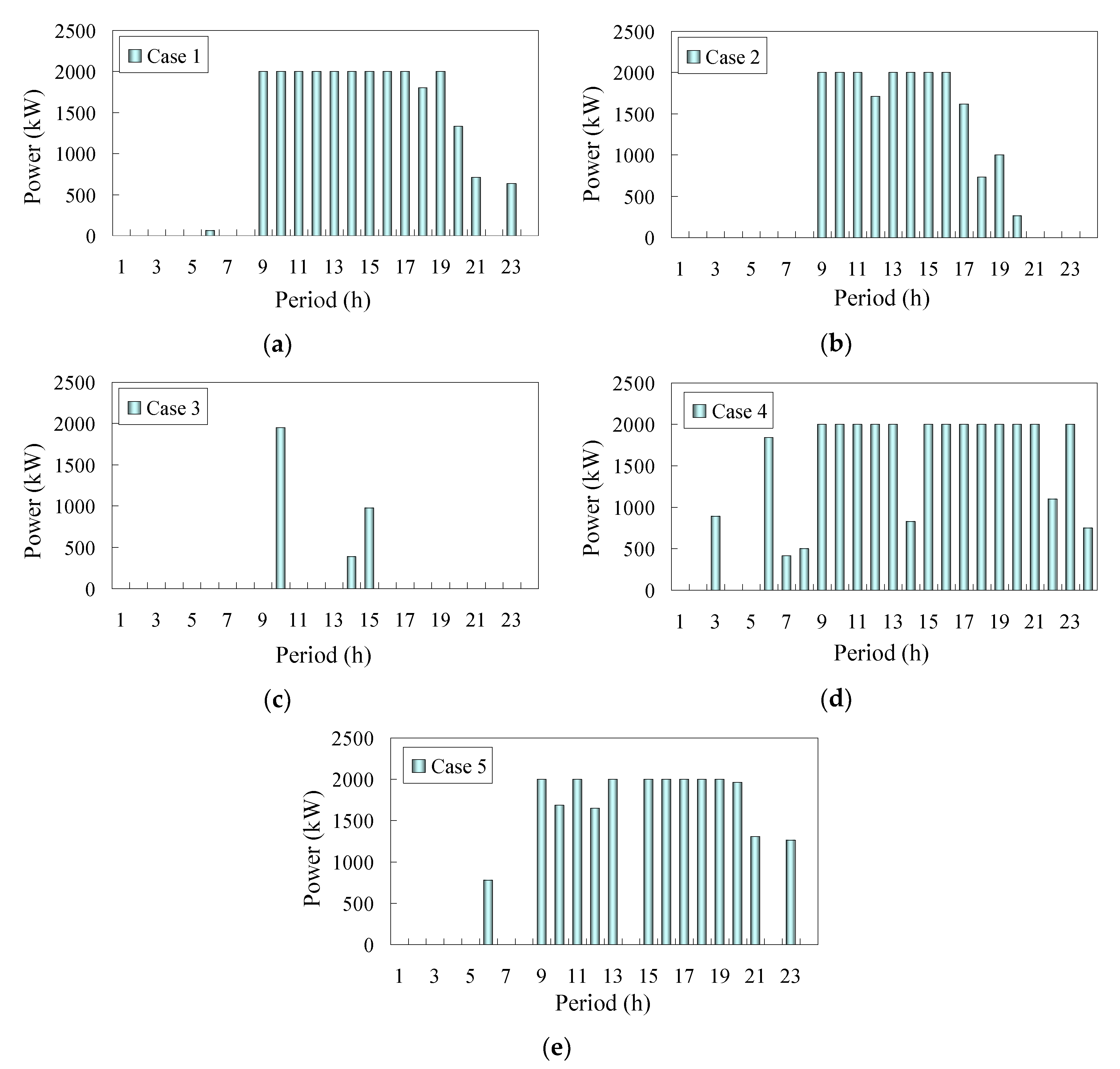
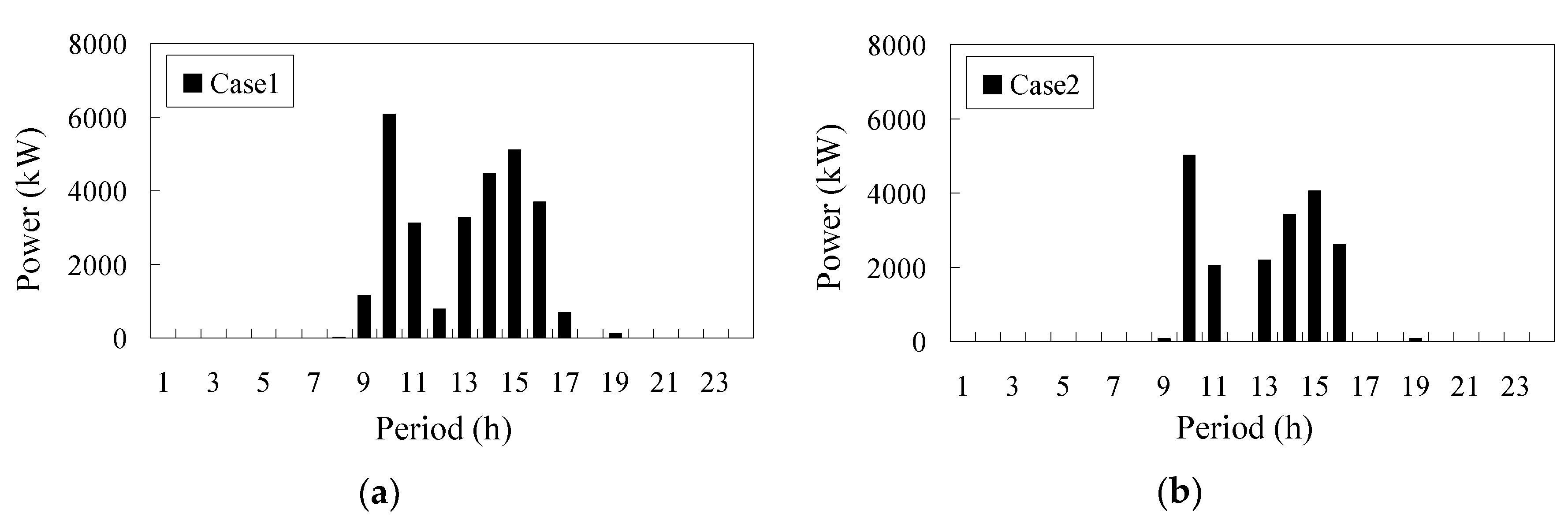
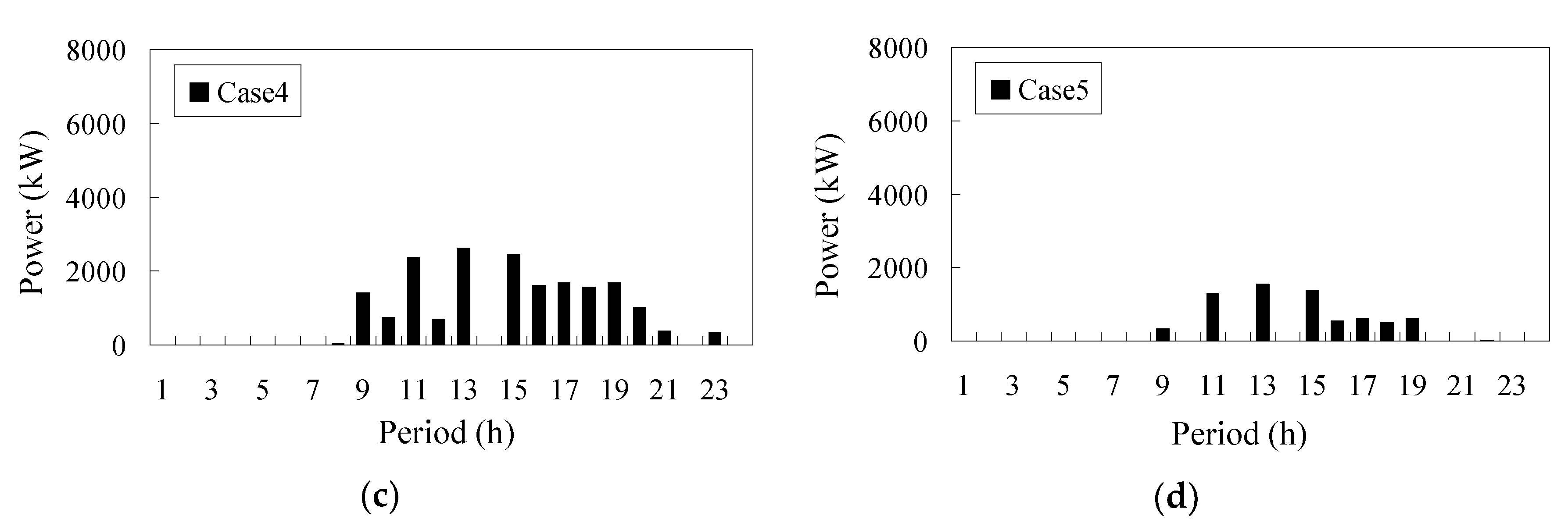
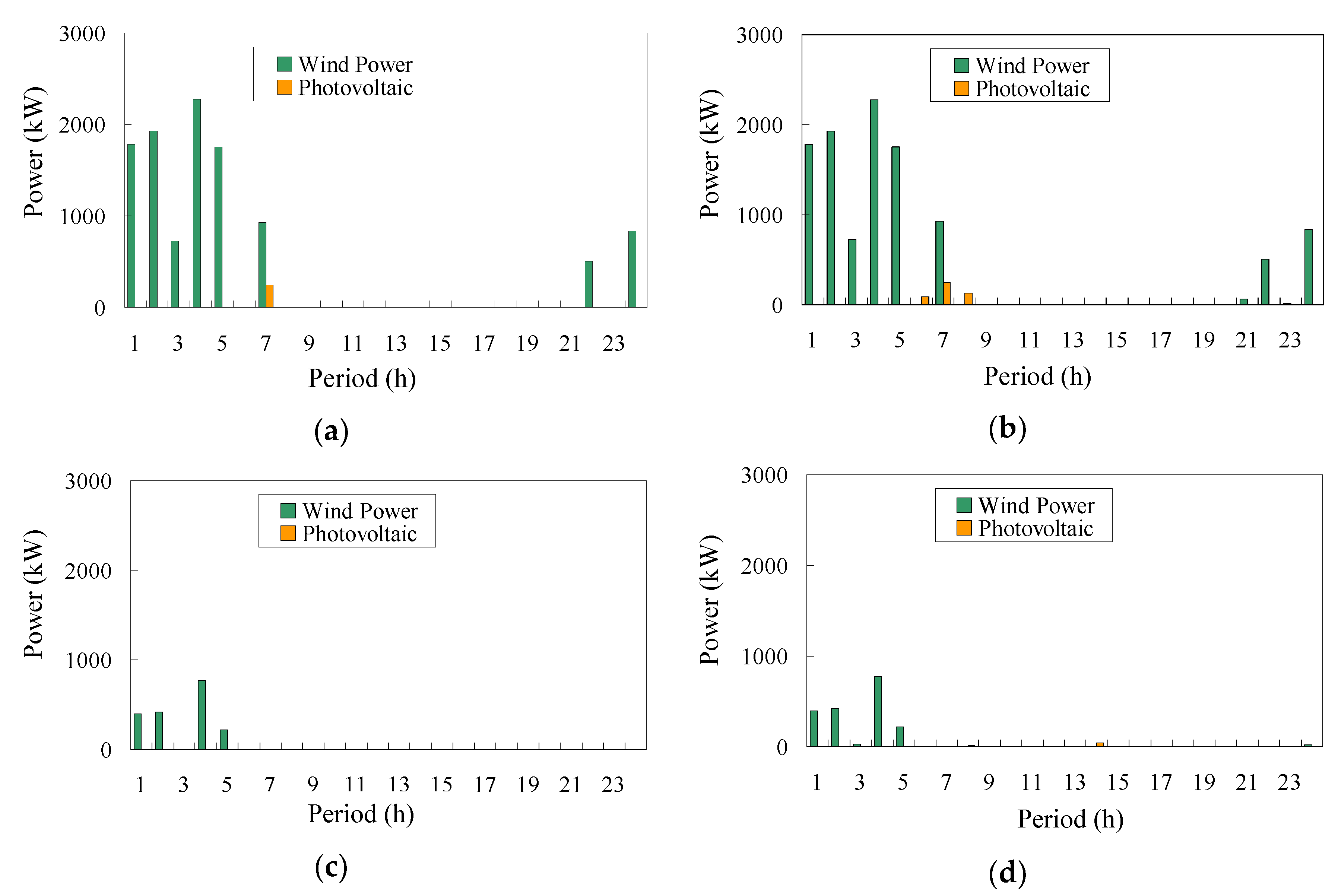
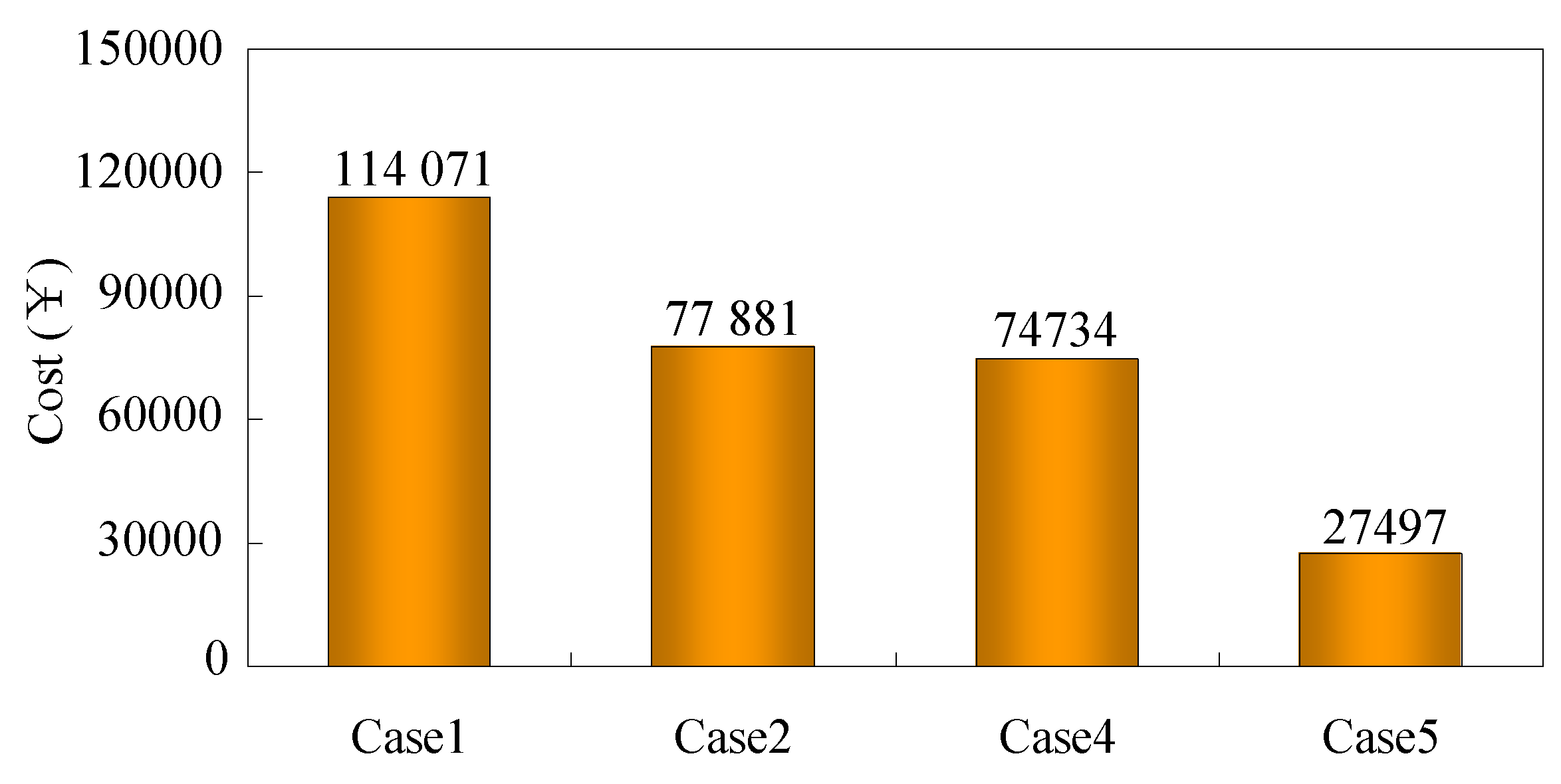
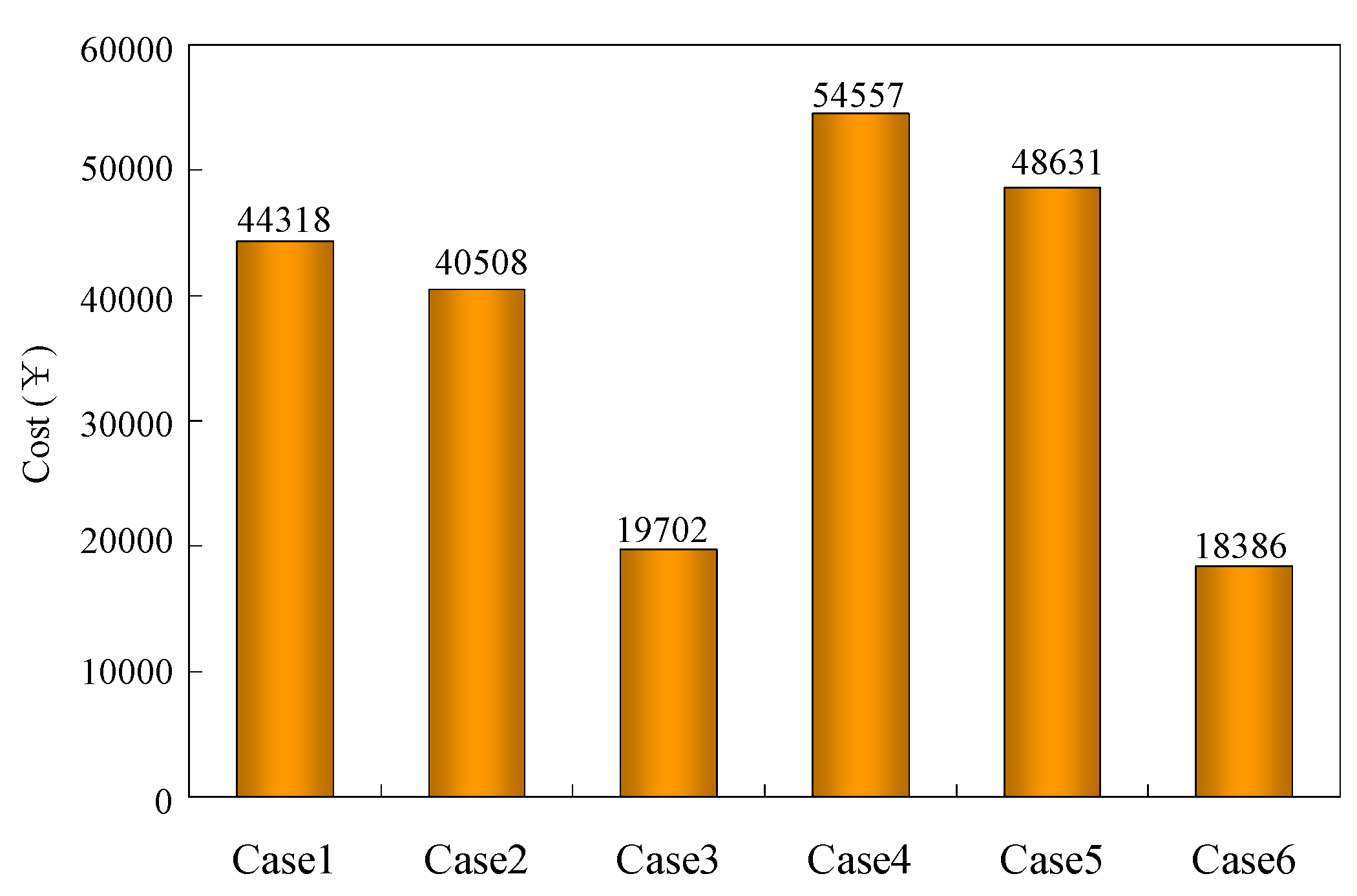
| / (kW) | kgen/kpump | Cgen/Cpump (¥) | / (¥/kW) | (¥/kW) | |
|---|---|---|---|---|---|
| Generating mode | 4000 | 0.92 | 300 | 0.15 | 0.05 |
| Pumping mode | 4000 | 0.78 | 400 | 0.15 |
| a | b | c | (kW) | (kW) | Con (¥) | Coff (¥) | NDE | (¥/kW) |
|---|---|---|---|---|---|---|---|---|
| 0.0015 | 0.348 | 228 | 50 | 500 | 50 | 5 | 4 | 0.1 |
| vc (m/s) | vr (m/s) | vf (m/s) | aw | bw | cw | Pwr (kW) | (¥/kW) | ηpv | (¥/kW) |
|---|---|---|---|---|---|---|---|---|---|
| 3.5 | 17.5 | 18 | 3.4 | −12 | 9.2 | 130 | 0.12 | 0.9 | 0.1 |
| Period | IL1 (Node1) | IL2 (Node5) | IL3 (Node7) | IL4 (Node9) | Period | IL1 (Node1) | IL2 (Node5) | IL3 (Node7) | IL4 (Node9) |
|---|---|---|---|---|---|---|---|---|---|
| 1 | 1 | 1 | 1 | 1 | 13 | 1 | 1 | 1 | 1 |
| 2 | 0 | 1 | 1 | 1 | 14 | 1 | 1 | 1 | 1 |
| 3 | 0 | 1 | 1 | 1 | 15 | 1 | 1 | 1 | 1 |
| 4 | 0 | 1 | 1 | 0 | 16 | 1 | 1 | 1 | 1 |
| 5 | 1 | 1 | 1 | 1 | 17 | 1 | 1 | 1 | 1 |
| 6 | 1 | 1 | 1 | 1 | 18 | 1 | 1 | 1 | 1 |
| 7 | 1 | 1 | 1 | 1 | 19 | 1 | 1 | 1 | 1 |
| 8 | 1 | 1 | 1 | 1 | 20 | 0 | 1 | 1 | 1 |
| 9 | 1 | 1 | 1 | 1 | 21 | 0 | 1 | 1 | 1 |
| 10 | 1 | 1 | 1 | 1 | 22 | 0 | 1 | 1 | 1 |
| 11 | 1 | 1 | 1 | 1 | 23 | 1 | 1 | 1 | 1 |
| 12 | 1 | 1 | 1 | 1 | 24 | 1 | 1 | 1 | 1 |
© 2020 by the authors. Licensee MDPI, Basel, Switzerland. This article is an open access article distributed under the terms and conditions of the Creative Commons Attribution (CC BY) license (http://creativecommons.org/licenses/by/4.0/).
Share and Cite
Liang, N.; Li, P.; Liu, Z.; Song, Q.; Luo, L. Optimal Scheduling of Island Microgrid with Seawater-Pumped Storage Station and Renewable Energy. Processes 2020, 8, 737. https://doi.org/10.3390/pr8060737
Liang N, Li P, Liu Z, Song Q, Luo L. Optimal Scheduling of Island Microgrid with Seawater-Pumped Storage Station and Renewable Energy. Processes. 2020; 8(6):737. https://doi.org/10.3390/pr8060737
Chicago/Turabian StyleLiang, Ning, Pengcheng Li, Zhijian Liu, Qi Song, and Linlin Luo. 2020. "Optimal Scheduling of Island Microgrid with Seawater-Pumped Storage Station and Renewable Energy" Processes 8, no. 6: 737. https://doi.org/10.3390/pr8060737
APA StyleLiang, N., Li, P., Liu, Z., Song, Q., & Luo, L. (2020). Optimal Scheduling of Island Microgrid with Seawater-Pumped Storage Station and Renewable Energy. Processes, 8(6), 737. https://doi.org/10.3390/pr8060737





